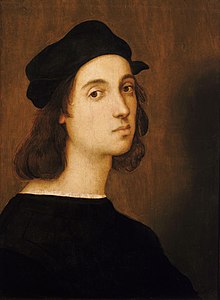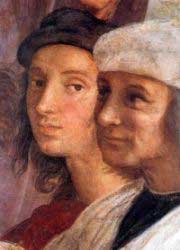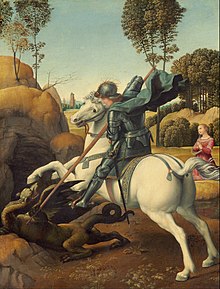Raphael
![]()
The title of this article is ambiguous. For other meanings, see Raphael (disambiguation).

Raffaello Sanzio da Urbino, also Raphael da Urbino, Raffaello Santi [rafːaˈɛlːo ˈsanti], Raffaello Sanzio [ˈsantsi̯o] or Raphael for short (* 6 April or 28 March 1483 in Urbino; † 6 April 1520 in Rome) was an Italian painter and architect. He is considered one of the most important artists of the Italian High Renaissance.
Raphael gained fame primarily as a painter for his harmonious and balanced compositions and lovely paintings of the Madonna. During his lifetime he enjoyed the privilege of being known only by his first name, and even today few people know his surname. Until well into the 19th century, he was considered the greatest painter of all time. In addition to his career as a painter in Florence and at the papal court in Rome, he also became the director of construction of St. Peter's Basilica and overseer of Roman antiquities.

Self-portrait of Raphael, 1506, Uffizi Gallery

Self-portrait (left), detail from The School of Athens, 1510/11, Vatican Stanzas
Evaluation of his artistic work
Raphael's work was entirely devoted to the ideal of beauty. For him, art, above all else, has aesthetic value; beauty is found in nature only imperfectly and scattered. Only art is able to reveal beauty "in its entirety and to realize it on the basis of an intellectual synthesis of experiences, through the 'certa idea' of the artist."
The newly formulated ideal of art at that time, "which combined beauty and truth with the authority of the classical-antique tradition and scientific foundations, became the norm and was to remain unshaken throughout the stylistic development of the modern era until more recent decades."
In his first artistic period in Florence from 1504 to 1507, Raphael engaged with all contemporary influences. Above all with Leonardo, Fra Bartolommeo and Michelangelo. His efforts to create his own formal language can be seen in the Madonna paintings and religious "state paintings" of these years.
In his second creative period in Rome from 1508 to 1513, the creative fulfilment of the High Renaissance idea took place, above all in the painting of the Vatican stanzas.
Towards the end of his life Raphael deepened the problems of form still further, to be seen in the painting of the loggias of the Vatican and in the frescoes of the Farnesina, which he designed, and which are executed with the highest antique serenity.
Raphael, by type a happy and unproblematic realizer, created in his life a wealth of naturally grown masterpieces. The rural surroundings of Urbino shaped his youthful work with intimate expression. In Rome his art took a significant turn "into the free and great and stepped out of the youthful-cheerful, playful-light early Renaissance into the full weight of the High Renaissance."

St. George Fighting the Dragon (1504-1506), National Gallery of Art, Washington
Pupil of Raphael
Raphael left behind a large band of pupils and collaborators, of whom Raffaellino del Colle, Giulio Romano and Francesco Penni, called Il Fattore, were the most creative greats. Other pupils, namely those who only came into contact with Raphael when they had already acquired their first artistic education, were Benvenuto Carosalo, Gaudenzio Ferrari and Timoteo Viti. Another pupil distinguished by talent and the gift of production was Perino del Vaga.
Since after the death of Leo X. in 1521 the artists no longer found employment, Raphael's school ceased to exist. The sack of Rome in 1527 completely dispersed the remaining students.
Questions and Answers
Q: Who is Raphael?
A: Raphael, whose full name is Raffaello Sanzio, was a painter and architect from the Renaissance period.
Q: Can Raphael be considered as one of the greatest painters of the High Renaissance?
A: Yes, along with Leonardo da Vinci and Michelangelo, Raphael is considered one of the three greatest painters of the High Renaissance.
Q: What is Raphael particularly known for in his paintings?
A: Raphael is particularly known for his paintings of the Madonna and Christ Child.
Q: Where did Raphael paint his famous works?
A: Raphael painted his famous works in the Vatican in Rome, Italy.
Q: When was Raphael born?
A: Raphael was born on April 6, 1483.
Q: When did Raphael die?
A: Raphael died on April 6, 1520, coincidentally his 37th birthday.
Q: What other profession besides painting was Raphael involved in?
A: Raphael was also an architect.
Search within the encyclopedia